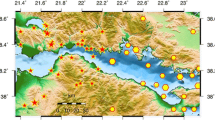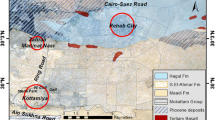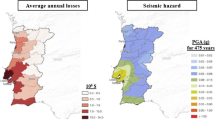Abstract
The long-term probabilistic seismic hazard of central Ionian Islands (Greece) is studied through the application of stress release models. In order to identify statistically distinct regions, the study area is divided into two subareas, namely Kefalonia and Lefkada, on the basis of seismotectonic properties. Previous results evidenced the existence of stress transfer and interaction between the Kefalonia and Lefkada fault segments. For the consideration of stress transfer and interaction, the linked stress release model is applied. A new model is proposed, where the hazard rate function in terms of X(t) has the form of the Weibull distribution. The fitted models are evaluated through residual analysis and the best of them is selected through the Akaike information criterion. Based on AIC, the results demonstrate that the simple stress release model fits the Ionian data better than the non-homogeneous Poisson and the Weibull models. Finally, the thinning simulation method is applied in order to produce simulated data and proceed to forecasting.
Similar content being viewed by others
References
Akaike, H. (1974), A new look at the statistical model identification, IEEE Trans. Automat. Contr. 19,6, 716–723, DOI: 10.1109/TAC.1974.1100705.
Bebbington, M.S. (2005), Information gains for stress release models, Pure Appl. Geophys. 162,12, 2299–2319, DOI: 10.1007/s00024-005-2777-5.
Bebbington, M., and D.S. Harte (2001), On the statistics of the linked stress release model, J. Appl. Probab. 38A, 176–187, DOI: 10.1239/jap/1085496600.
Bebbington, M., and D. Harte (2003), The linked stress release model for spatiotemporal seismicity: formulations, procedures and applications, Geophys. J. Int. 154,3, 925–946, DOI: 10.1046/j.1365-246X.2003.02015.x.
Daley, D.J. and D. Vere-Jones (2003), An introduction to the Theory of Point Processes, Volume I: Elementary Theory and Methods, 2nd ed., Springer.
Harte, D. (1998), Documentation for the Statistical Seismology Library, School of Mathematical and Computing Sciences Research, Report No. 98-10 (updated ed., June 1999), Victoria Univ., Wellington.
Hong, L.-L., and S.-W. Guo (1995), Nonstationary Poisson model for earthquake occurrences, Bull. Seismol. Soc. Am. 85,3, 814–824.
Kanamori, H., and D.L. Anderson (1975), Theoritical basis of some empirical relations in seismology, Bull. Seismol. Soc. Am. 65,5, 1073–1095.
Kagan, Y.Y. (1991), Likelihood analysis of earthquake catalogues, Geophys. J. Int. 106,1, 135–148, DOI: 10.1111/j.1365-246X.1991.tb04607.x.
Kagan, Y.Y., and D.D. Jackson (1991), Long-term earthquake clustering, Geophys. J. Int. 104,1, 117–134, DOI: 10.1111/j.1365-246X.1991.tb02498.x.
Knopoff, L. (1971), A stochastic model for the occurrence of main-sequence earthquakes, Rev. Geophys. 9,1, 175–188, DOI: 10.1029/RG009i001p00175.
Lewis, P.A., and G.S. Shedler (1978), Simulation of Nonhomogeneous Poisson Processes by Thinning, Technical Rep. 43, 403–413.
Liu, J., D. Vere-Jones, L. Ma, Y. Shi, and J.C. Zhuang (1998), The principle of coupled stress release model and its application, Acta Seismol. Sin. 11,3, 273–281, DOI: 10.1007/s11589-998-0035-5.
Liu, J., Y. Chen, Y. Shi, and D. Vere-Jones (1999), Coupled stress release model for time-dependent seismicity, Pure Appl. Geophys. 155,2–4, 649–667, DOI: 10.1007/s000240050281.
Lu, C., D. Harte, and M. Bebbington (1999), A linked stress release model for historical Japanese earthquakes: Coupling among major seismic regions, Earth Planets Space 51, 907–916.
Ogata, Y. (1981), On Lewis’ simulation method for point processes, IEEE Trans. Inform. Theory, 27,1, 23–31, DOI: 10.1109/TIT.1981.1056305.
Ogata, Y. (1988), Statistical models for earthquake occurrences and residual analysis for point processes, J. Amer. Statist. Assoc. 83,401, 9–27, DOI: 10.2307/2288914.
Papadimitriou, E.E. (2002), Mode of strong earthquake recurrence in the Central Ionian Islands (Greece): Possible Triggering due to Coulomb stress changes generated by the occurrence of previous strong shocks, Bull. Seismol. Soc. Am. 92,8, 3293–3308, DOI: 10.1785/0120000290.
Papadimitriou, E.E., and B.C. Papazachos (1985), Evidence for precursory seismicity patterns in the Ionian islands (Greece), Earthq. Pred. Res. 3, 95–103.
Papazachos, B.C., G.F. Karakaisis, E.E. Papadimitriou, and Ch.A. Papaioannou (1997), Time dependent seismicity in the Alpine — Himalayan Belt, Tectonophysics 271, 295–324, DOI: 10.1016/S0040-1951(96)00252-1.
Rathbun, S.L. (1996), Asymptotic properties of the maximum likelihood estimator for spatio-temporal point processes, J. Statist. Plan. Infer. 51, 55–74, DOI: 10.1016/0378-3758(95)00070-4.
Rotondi, R., and E. Varini (2003), Bayesian analysis of a marked point process: Application in seismic hazard assessment, Statist. Method. Applic. 12, 79–92, DOI: 10.1007/BF02511585.
Rotondi, R., and E. Varini (2007), Bayesian inference of stress release models applied to some Italian seismogenic zones, Geophys. J. Int. 169, 301–314, DOI: 10.1111/j.1365-246X.2006.03314.x.
Vere-Jones, D. (1970), Stochastic models for earthquake occurrence, J. Roy. Stat. Soc. 32,1, 1–62.
Vere-Jones, D. (1978), Earthquake prediction — a statistician’s view, J. Phys. Earth 25, 129–146.
Vere-Jones, D., and R.B. Davies (1966), A statistical study of earthquakes in the main seismic area of New Zealand, New Zeal. J. Geol. Geophys. 9, 251–284
Zheng, X., and D. Vere-Jones (1991), Application of stress release models to historical earthquakes from North China, Pure Appl. Geophys. 135, 559–576, DOI: 10.1007/BF01772406.
Zheng, X., and D. Vere-Jones (1994), Further applications of stress release models to historical earthquake data, Tectonophysics 229, 101–121, DOI: 10.1016/0040-1951(94)90007-8.
Author information
Authors and Affiliations
Corresponding author
Rights and permissions
About this article
Cite this article
Votsi, I., Tsaklidis, G.M. & Papadimitriou, E.E. Seismic hazard assessment in central Ionian Islands area (Greece) based on stress release models. Acta Geophys. 59, 701–727 (2011). https://doi.org/10.2478/s11600-011-0020-6
Received:
Revised:
Accepted:
Published:
Issue Date:
DOI: https://doi.org/10.2478/s11600-011-0020-6




